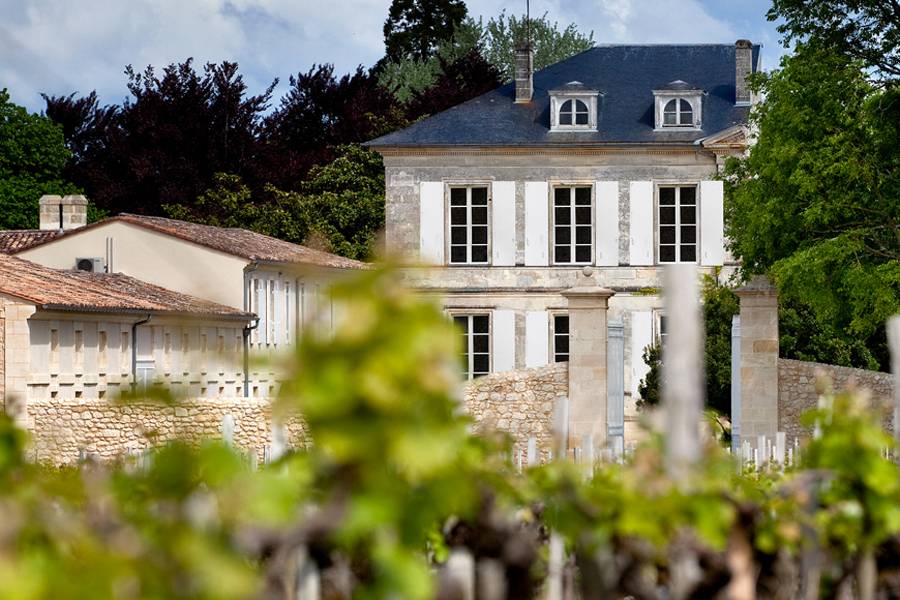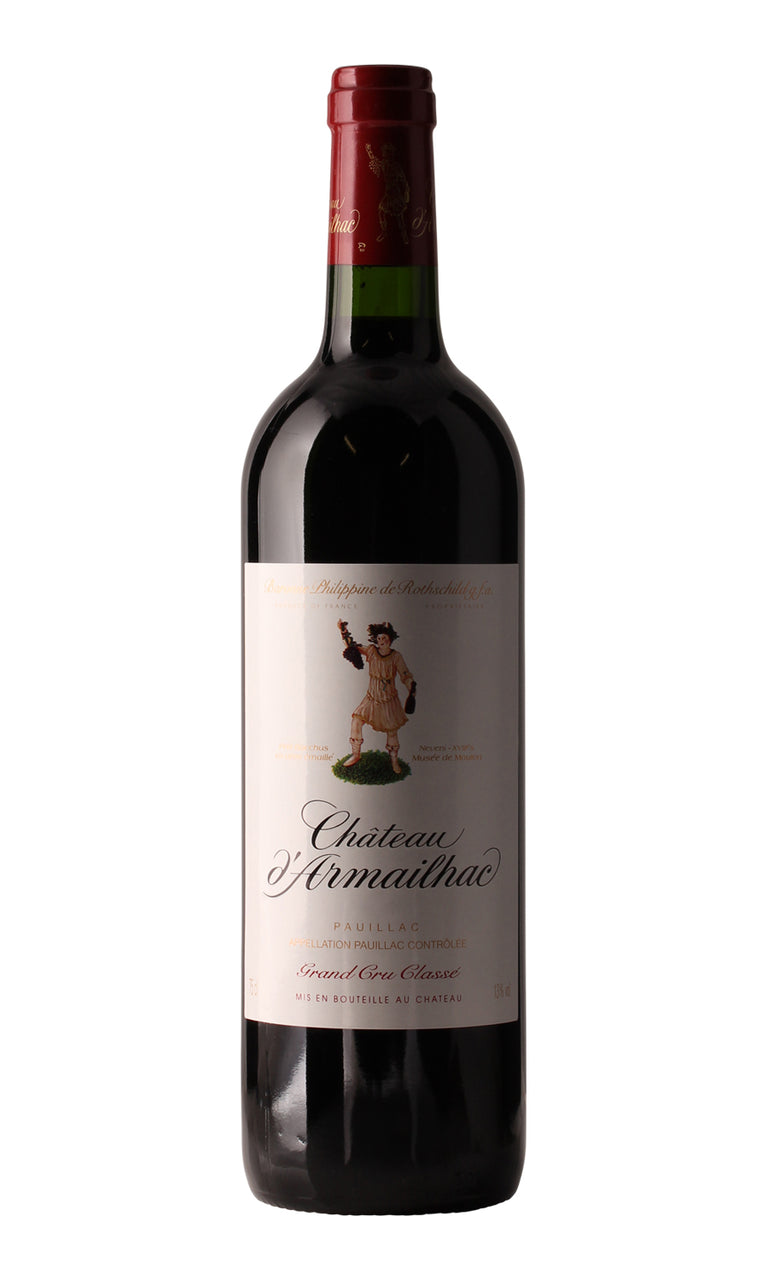- Colour Red
- Producer Château d'Armailhac
- Region Pauillac
- Drinking 2023 - 2035
- Case size 6x150cl
- Available Now
2016 - Ch d'Armailhac 5ème Cru Pauillac - 6x150cl
- Colour Red
- Producer Château d'Armailhac
- Region Pauillac
- Drinking 2023 - 2035
- Case size 6x150cl
- Available Now
Select pricing type
Need help? Call +44 (0)20 7793 7900 or email wine@goedhuiswaddesdon.com.
-
Goedhuis, April 2017, Score: 92-94
Another Pauillac property in the Baron Philippe de Rothschild stable. Deep purple hue, the scent of smoky, toasty oak circles around dark fruit aromas. There is a chalky freshness to the tannins and vibrant acidity, with a long, lively finish. CP
-
Neal Martin, January 2019, Score: 93
The 2016 d’Armailhac, which was bottled in May 2018, has an elegant bouquet that unfolds in the glass, offering blackberries, briar and a touch of cedar and mint. The palate is medium-bodied with dense tannin, grippy in the mouth, and quite voluminous, with perhaps more density on the solid, almost broad-shouldered finish compared to the Clerc-Milon. This fulfills all my expectations from my barrel tasting and is quite simply one of the best d’Armailhac wines ever made. 2022 - 2040
-
Neal Martin, April 2017, Score: 92-94
The 2016 D'Armailhac is a blend of 62% Cabernet Sauvignon, 28% Merlot, 8% Cabernet Franc and 2% Petit Verdot that was picked between 27 September and 14 October. The bouquet is very impressive, typical d'Armaihlac in terms of the opulence and flamboyance with lush black cherry and boysenberry fruit, a subtle floral note developing with time in the glass. The palate is medium-bodied with a crisp and tensile entry; there is immense purity here with some lovely blue fruit appearing on the finish. This is a d'Armailhac that is emboldened by unprecedented tannic structure that gives it real backbone and a sense of authority. Quite simply, this is one of the best wines of Château D'Armailhac that I have tasted, somehow not a million miles away from Grand Puy Lacoste in style. Drink Date 2021 - 2045
-
Antonio Galloni, January 2019, Score: 92
The 2016 d'Armailhac is powerful and dense, just as it was from barrel. Readers will have to give the 2016 at least a few years in bottle, as the tannins are imposing. Dark red plum, licorice, spice, iron, game and scorched earth all give d'Armailhac its distinctive savory flavor profile that is quite appealing. Time in the glass brings out additional layers of nuance that complete the wine nicely. 2023 - 2036
-
Antonio Galloni, April 2017, Score: 89-91
The 2016 d'Armailhac is surprisingly dense and powerful, almost shockingly so. A burst of sweet red cherry, tobacco, smoke, earth and grilled herbs gives the wine a smoky, savory dimension that is quite attractive and nicely complements the intense fruit. Far from an easygoing wine, the 2016 is massively tannic, even if that is not always evident because of the wine's raciness and pure fruit density. The Cabernet Sauvignon is especially dominant today. D'Armailhac often develops into a fairly rustic Pauillac, so it will be interesting to see what happens here. Tasted three times.
-
James Suckling, April 2017, Score: 95-96
This is really tannic and muscular for d’Armailhac. Perhaps the most powerful ever. Full and chewy yet balanced and polished. Very, very impressive. Greatest ever?
-
Decanter, April 2017, Score: 93
Such richness through the palate, with deep crushed blackberry notes alongside soft coffee bean. I get hints of Petit Mouton here. The Mouton stable measure their tannins in weight, not IPT, and this year comes in even higher than 2010, 4.5g compared to 4g. You don't feel it because the grain of the tannins is so fine, but it is clearly going to age well, without any dryness. Incredible balance, with a pH of 3.55 giving freshness to the alcohol, and making these wines really not very difficult to taste. 62% Cabernet Sauvignon, 28% Merlot, 8% Cabernet Franc and 2% Petit Verdot, to be aged in 30% new oak.
-
Matthew Jukes, April 2017, Score: 17.5+
This is a tight, firm, slightly tense d’Armailhac with sour fruit and a distinct lack of juiciness. The nose is introverted showing earthy, skinsy notes and the palate, while long, is unresponsive. This coating of firmness hides a plummy core which is reluctant to show itself right now but which also looks rather ravishing with some vigorous swirling. I think that this will work well, but you must give it time.
-
Jancis Robinson, April 2017, Score: 17-
Very dark, blackish purple. Perfumed and rather seductive. Pretty chunky and solid. Tannins more in evidence than in some (though admittedly this is my first Pauillac in a long run of wines). A long-distance runner. Very juicy. Drink 2027-2045
-
Tim Atkin, May 2017, Score: 91
A wine that always delivers on the value for money front, this is a serious, well made red that doesn’t lack ambition. The oak is a little prominent, but there’s more than enough leafy fruit sweetness and fine-grained tannins to soak it up. 2020-28
Producer
Château d'Armailhac
For years this château had an identity crisis having almost as many names as France has had republics. It was created in the 18th century by Dominique d'Armailhac from a section of land situated between Mouton Rothschild and Pontet Canet and hence named Mouton d'Armailhac. In 1933, it was acquired by the Mouton branch of the Rothschild family and in 1956, its name was changed to Mouton-Baron-Philippe after Philippe de Roths...Read more
For years this château had an identity crisis having almost as many names as France has had republics. It was created in the 18th century by Dominique d'Armailhac from a section of land situated between Mouton Rothschild and Pontet Canet and hence named Mouton d'Armailhac. In 1933, it was acquired by the Mouton branch of the Rothschild family and in 1956, its name was changed to Mouton-Baron-Philippe after Philippe de Rothschild. Almost 20 years later, the Baron Philippe'swife died, and he changed the name to Mouton-Baronne-Philippe in her memory. If that was not enough, in 1989 the name reverted back to d'Armailhac in order to curb confusion with their brand, Mouton Cadet. Despite its chameleon-like name changes, for the past 20 years its quality has been consistent...Read less

Region
Pauillac
Due south of St Estèphe lies the appellation of Pauillac, the king of Left Bank communes. It is home to three first growths as well as a plethora of other classified growths. Pauillac's renowned well-draining, gravelly soils enable its dominant grape Cabernet Sauvignon to reach fantastic heights of complexity and concentration. As a result, Pauilac's wines tend to be full-bodied with compact tannins and good freshness. Its aromatics are often what one associates with classic Bordeaux: pencil shavings, black currant and occasional mint. Some of the most famous châteaux of the commune are Latour, Mouton Rothschild, Lafite Rothschild, Pichon Baron, Pichon Lalande and Lynch Bages.




